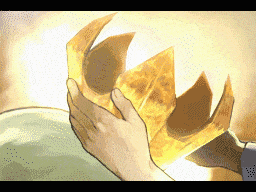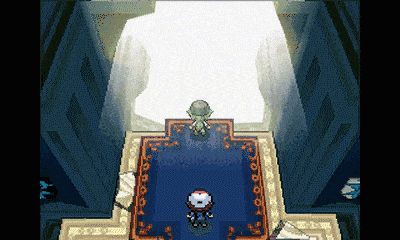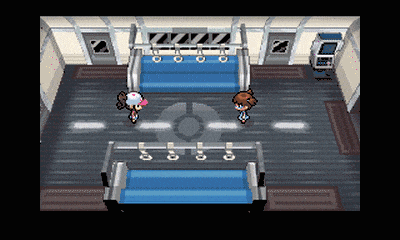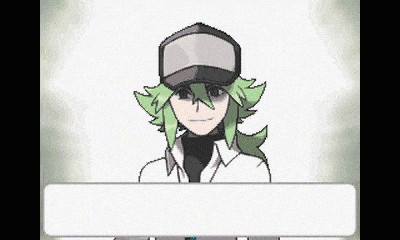A World Full of Love
Sean Chua

1.
Storytelling is scant in the Pokemon games. Cutscenes are always minimal. Dialogue is delivered through a string of encounters which are quickly skipped over in favour of the core gameplay loop: walking, battling, making numbers go up. Amidst this landscape, an absence is conveyed. Grinding consists of a motion — an upwards, spiralling, motion palpable in the side-scrolling of grass and the flowing of water. The screen flows backwards. Your character moves forwards and your sprite is rooted on the dead center of the screen.
This is not a metaphor yet. All games act as conduits for player agency. Some centralisation is inevitable. Pokemon Black and Pokemon White are no exception. At the time of those games' release — revolutionary, momentuous, celebrated through giveaways and parade floats through Times Square — the franchise was already more than a decade old. With a desire to say something new, the games palpably chafe against old ways. On the one hand there is the gameplay loop: the walking, the battling, the numbers game of moves and levels and stats. On the other hand there are the discontinuities. Something scrapes against the grain here. It is present in the interface and it is present in the story. It is present in what the characters do and say. It runs into the games' very bones.
Ostensibly, the two games tell a story about change. In them, the seasons change once a month, bringing forth new eyecatches, new maps, new Pokemon formes. The DowsingMchn, a key item obtained halfway through the main storyline, serves as a literal pointer to such change: the beeping pair of rods point towards unmelted snowbanks, leaf-strewn pits, tantalising islands separated by plains of unnavigable ice. They point towards directions in space as well as time. Many other visual elements of the game do this. The first area, Route 1, is marked by a perpetual westward breeze. (Nice winds, dude. Are those also of change?)
This is a game on the cusp of Post-Occupy, post-Obama election campaign 2009: easy for the liberal zeitgeist to latch onto images of the protestor, the activist, etc. as morally meaningful forces. Distilled as such, the role of the games' antagonists—a PETA-lite anti-Pokemon-captivity cult by the name of Team Plasma—is clear. This was no better time for the sympathetic radical in fiction; for liberal media to point and say, 'hey, those guys kinda have a point.' The promise of change drives Team Plasma's demagoguery, their every in-game speech punctuated with a flurry of anonymous NPC comments: is training Pokemon wrong? Do the bad guys have a point? Are we, instead, the baddies? So revolutionary is this direction that the games do not know how to proceed coherently beyond this point. We meet bad grunts (whom we overcome in battle) and good grunts (who appear to begin reconsidering their ways). We meet repentant Plasma elders and their irredeemably evil leader, Ghetsis. Nothing is said of the primary discomfort raised by their introductory speeches. Which makes the promise of change ring kind of hollow; though charitably speaking I want to say that's the point. This is not a game about the change of any particular quantity. This is a game about the motion of change, and what it can indicate despite itself.
Such is the way of all stories written by committee and shareholders. These stories cannot be about anything more than the conflicting interests of a dozen professional writers can coherently be summed up as 'any thing'. It can only be about directionalities, patterns, beats; a kind of virtual rhythmanalysis. In this way, the constant, hollow motion of the player character becomes central to the direction of the piece. When people talk about books where things appear to happen under the surface — a happening discerned despite the lack of a tangible development of plot — they call it an undercurrent, or a stirring. The plot of Pokemon Black and White does not advance ideology; it is a stirring. Yet to stir is not to remain stagnant to the point of non-sensibility. There is a story to be found in stirring. Keep this in mind for later.
This metaphor extends to the platform of the games themselves. Straddling sprite graphics and 3D projection; on the eve of the 3DS's launch; Pokemon Black and Pokemon White are in many ways transitional games. Grandiosely, the player is offered the chance to move beyond the series' tried-and-tested grid maps through several setpieces containing curved, guided rails.(On Skyarrow Bridge, an NPC remarks, "This curve is like nothing I've ever seen in my life!") In Castelia City, hub of Unovan plurality &inclusivity, the game surrounds the player in a five-pronged radial grid. Vast cliffs at late-game routes jut beyond the screen, as if anticipating the 3DS's faux-depth projection to come. Even the battles pan and zoom the sprites dynamically to produce the illusion of life. The effect is crunchy, crispy, between-worlds. Even today, the style oozes an exuberance the later fully-3D games have failed to capture (perhaps prophesised by Pokemon X and Pokemon Y's lacking the third edition of Z) — a sense of self-aware wonder, of improvised play. I argue, here, that it's the movement that counts — the aesthetics of transitionality, the very look and feel of change in itself, that mobilises the texture of the world.
Confined to the technological tarpit of an end-of-life game system, and the ideological morasse of marketable family-friendly centrism, it is a wonder the game feels like any journey at all. Certainly it feels more so than most other core games in the series. And look how it strains at its bones: look at how the the pixels crack and tumble under the zoom effects that pass for depth, look how the 256x192 screen squints at the detail of the Skyarrow Bridge's renderite trusses. These are the chafings, the discontinuities, that highlight the world's failings as well as its greatest strengths. We are trying every day to make a story for ourselves which the world will not fit. The world will swell and warp us until we are only recognisable as illusion. We await the platform beyond.

2.
N is a product of this movement. He's Team Plasma's mascot, the adopted son of Ghetsis, and easily the game's deuteragonist. He is on a journey, though the game is initially vague as to his goal. Eventually he promises to conquer the Pokemon League before you and catch the legendary Pokemon of the game's colour: the trajectory of every core series' player character thus far. He mirrors the hypothetical player in playstyle: like yours, his team swells with every new route, never committing to a particular type. As a foil, he is the only character whom the player is fully allowed to face in person; he is the only character who appears as an anime-style illustration, face-to-face (and not as a sprite on the XTransceiver!), blinking and smiling and moving. He is the only character permitted to approach an illusion of life beyond the limitations of the world.
(The illusion is not discarded in the abstraction of battle. While every other rival's challenge is prefaced by an eyecatch of their sprite opposite the player character's, N's five battles are preceded with his sprite and his alone. Here's looking at you, kid.)
(It is decidedly also not a coincidence that he, like most player characters, has changed his text to the fastest settings.)
The two of you clash repeatedly. Even the very idea of prolonged rivalry skids against the game's core: with every one of your assured victories, you are reminded of Pokemon's linearity, of the impossibility of parallel narratives when the player occupies the dead centre of the screen. And yet N persists, faithful in his belief that injustice can only be resolved through decisive, monolithic action driven by the strength of conviction and the pureness of heart.
The core driver of these beliefs is that coexistence between human and Pokemon is impossible. Ghetsis raised him wrong as a joke. Surrounded by abused Pokemon, N firmly believes in their liberation from the trainer-breeder complex: a state of affairs whose immutability is painfully evident to the player via the very interface of the game. Capturing the legendary Pokemon, he says, will convince the world of his viewpoint: an in-universe will-to-power through which revolution can be achieved. This change, predictably, never comes. The game does not bend for us and it does not bend for him. The citizens of Unova move and fight on scripted rails. His idealism rings empty. It is hard to imagine otherwise: how would one fight for the agency of all beings in a game where all beings are deterministic agents of code?
That is why when he speaks, he is speaking to you.
This is the game speaking to you, in text boxes and beeps, that becoming-with cannot be possible. That their world is a world of binaries, of grids, of things laid out neatly in a line. N's trademark trinket — the Menger sponge clipped to his belt, whose presence is never mentioned and its significance never discussed — speaks of subdivisions upon subdivisions, a structure whose fractal nature nevertheless belies a recursively predictable form. His message strains the medium's disbelief. It speaks of unmappable quantities exceeding the game's inflexible bounds. It urges, despite itself.
At one point of the game, the two of you share a quiet moment on a Ferris wheel. The two of you are still sprites, while the impossible form of the ferris wheel — its painstakingly modelled curves — lifts along the Z-axis into the sky.
(I think about that moment a lot.)
The game's final message hints at a certain productive agonism: that differences must coexist, stirring endlessly, perhaps shaping something as abstract as 'dreams' or 'hopes', never resolving into action. N and the player stir endlessly, never resolving into anything more than platitudes and experience points. Much remains unsaid. At the end of the main storyline, N — as all misfits do — disappears through a hole in a wall, never to return.
There is a story to be told in the stirring.

3.
Near the end of Pokemon Black and White — after N, in a move unprecedented for an in-game foil, has captured and tamed the legendary dragon of the game's colour — an NPC says to the player character, "He's going to change the world, isn't he?"
This world — this written-by-committee, AB-tested, inertially-dampened, world — the world of transitional 2.5D, the world bursting at the dithered seams. The world of the hero at the centre of the screen, who always presses B and always wins. The world of the battling-catching-training paradigm, the world at the heart of a 1.5-billion-dollar franchise.
To overturn such a world requires more than conviction and purity of heart. It requires more than even a jet-black/snow-white dragon with a fusion reactor for a tail. To do so requires a force beyond the world, whose outline cannot be charted within the cartridge. This is how theory remains theory: by continuing to gesture at a world beyond our own.
N doesn't know any of this. N is of the world. All N knows is the numbers. N is numbers: the health bars of his Pokemon go down, the memory registers in which his team is stored go up, the thrum of his heartbeat under the cascading synths of his theme tune. (And what a theme tune it is! The soundfont pops, twirls, and sparkles; idealism rings.) The ascending arpeggios preceding every battle are prime-numbered intervals on the scale, representing indivisibility between his convictions and the indivisible One. It's fitting when you triumph at the end: he loses, he changes his mind. There is no grey area to dither. There is no 'draw' in a Pokemon game. The status quo remains unsullied.
Do you smell the desperation? The animal stench of contradiction? It's nauseating to imagine the alternative. ("It is easier to imagine the end of the world than to imagine the end of the 1.5-billion-dollar franchise.") N is the game reminding you — and, by proxy, reminding itself — of its impossibilities. He is the franchise's ultimate Godel statement, its self-destructive Id, its blackpilled doomer femboy. Even deradicalised, he remains an ontological threat. He cannot be allowed to persist.
Only the player is allowed to consider him an equal — and only for the briefest of moments on the Ferris wheel, face-to-face in the most impossible of in-game dimensions (up), in text bubbles so fleeting they may as well not be real.
But it's real. We remember. We've through played this game twice. We're gunning for that perfect ending. We're gunning for our special boy.

4.
In Pokemon Black 2 and Pokemon White 2, there is something at the edge of the world's vision. You're a new trainer now, in new clothes and a new city, though the rhythm remains the same: walk, fight, win. Make those numbers go up. Here you can be the new hero again, the new rising star.
The developers eschewed the moral complexity of the previous games for a simpler tone: Team Plasma's back, they're evil, they're here to finish what they started for good. Their new leader — a charismatic scientist named Colress — has dreams of "bringing out the strength of Pokemon". Little is said about how he exactly plans to achieve it. This is convenient for the player, for it gives their justice no bounds. (All acts are acceptable because the enemy is not.)
It's all too straightforward, too clean. There's a shadow at the edge of this world. There's talk about the trainer of two years prior; the kid with the legendary dragon, with the pure heart and the indomitable team. Sometimes the player character reminds others of them. It's all very metatextual: Cynthia, the champion of the franchise's previous games, refers to the player character as such when you encounter her in her villa in Pokemon Black and White and its sequels. This exceptionalism carries with it a certain wistfulness. Perhaps it's a certain NPC post-trauma, a collective reeling from the impact of Pokemon Black/White's high-stakes ending. The game is trying to remember your player character and their actions but it cannot quite muster the strength. In the span of two years, something's changed in the tenor of the world.
This is no longer a world of moral ambiguity. Despite the NPCs' resounding affirmation — louder than ever before — that Pokemon and humans were always meant to work together, that change cannot happen without a healthy coexistence of views — the very fact that the main agents of moral complexity (N and the player character) are missing hangs in the world like a deafening silence. It's like a reverse death of God — the act of rebellion in the first games, that grand questioning of Pokemon's essential paradigm, allowed the world of the game to rise beyond itself, to rise to the level of the player, to throw them the hard questions and smile and nod and battle them for it eye-to-eye beneath a Ferris wheel. No equivalent complexity exists in the sequels. Drained of such tension, the world of Black 2 and White 2 no longer strains beyond its seams.
With every mounting reference to the missing player character, this silence looms. It builds while the player retraces their steps through Castelia City, through the gyms, through the wreckage of the collapsed Victory Road. NPCs mention the former player character and praise their excellence, their many achievements, even as the new player character grows to rival them in stature. It is not until the post-game that the player character is finally allowed to access Skyarrow Bridge — and with it, backtracking Black and White's early-game routes down Pinwheel Forest, Nacrene, Striaton, Accumula. You have, by that point, truly 'walked the world'. You coast down Route 1 back to Nuvema Town — the first town you start from in Pokemon Black and White and the final destination in the sequels which you can Fly to in the entire game.
In the former protagonist's house, you find their mother at the table. She startles easily, believing you to be her child (the silence builds). Composing herself, she tells you that her child has been missing for two years: gone in search of their friend on the legendary dragon. No other trace of them is found in the sequels. The idea of seeking hangs in the air.
Pokemon Black and White are games about change, not because of — but in spite of — its platform limitations and entrenched franchise norms. To change the world is to exceed and succeed it. This succession takes place two real-world years later (and two in-game years later) in the sequel through this story of silence.
All those feelings had to go somewhere. With no game left to hold them, the only way left was through.

5.
The rhythm of the Pokemon series harboured an unsettling problem at the heart of Black and White: how to make progress in a world where everything returns to the centre, towads the fixed player. In Pokemon Black and White, a solution was proposed in the spectre of N. He, however, remains confined to the cartridge's four walls. To surpass that, we needed something we could believe in outside the bounds of the game. Pokemon Black 2 and White 2 attempted this through the processing of the old player character's absence.
This isn't mourning or grief; that's far too dark (and railroads the emotions so easily). An absence haunts the world on its own terms, leaving the player to imagine, to wonder, to theorise. This is a strange case of the future imaging its own past, in a way permitting — nay, demanding — extra-textual possibilities. It is precisely because the world of Black 2 and White 2 lies in the future that such projections of the past can be made. What does this imply about the distance between your current and former player characters? Between the former player character and N? What possesses a 16-year-old character (their gender, after all, remains indeterminate in the sequels) who has transcended the bounds of the game — transcended all available player actions, in fact — in search of that wonderful, effeminate boy? Is it love? Is it something more?
Presented with the intensity of such an absence, we lack the words for expression. It's a yearning, I think. The old trope: "We'll find each other again, even in another life." Another game, another world, another set of rules. Another frame of reference more tolerant than our own.
This is the culmination of the movement which began at the border of Nuvema Town two years ago; ending, Utena-style, with the elimination of Black and White's player character. We've gunned for that perfect ending at the cost of losing ourselves.

6.
In Black 2 and White 2, something of an ending exists.
Deep into the postgame, N confronts the player character. The world does not need saving. There are no more battles to be won. In the heart of an enormous mountain, the boy hands you an ultimatum. He's seen enough in two years -- he needs to pass the torch. He offers you the legendary dragon of your version's colour. He offers you the chance to change the world.
"I... want to see what no one can see," he admits.
The fight with the boy is quick and bloodless. He sends out only the dragon. You defeat the dragon, claim your prize, and leave.
Before you do, he bids you make him a promise. The boy dreams of a world where the instruments of control are gone. In another time, perhaps friendship between humans and Pokemon will blossom without Pokeballs — a way of relating free from pretenses, without blood. Uttered so close to the end of the game — a game, mind you, so devoid of any other such moralising — the words appear precious. There is no scripted repetition, no coming back to them after the end. One must pause to take in the implications. Under the mountain, the player and N must contend once again with the impossibility of the end of the world.
You journey, as in the first games, to Unova's highest point, to a tower above the clouds, to unleash and claim your prize. N appears for the second-to-last time, reaffirming your commitment to the promise. It's a promise of a world of becomings -- to see it through, in some future, some time.
"I look forward to seeing how full of love that world is," he says.
The location of that future remains indeterminable within the bounds of the game. You know this, for there's nothing left to do in this savefile. This world is long barren, its experience points stirred into exhaustion.
By elimination — once again — the only way forward is through.

7.
It's premature to call Pokemon Black and Pokemon White — and their sequels—excercises in deconstruction. True deconstructions follow through with the weight of their premises; the wrecking ball of trope implications must swing uninterrupted; the assumptions of the setting must be allowed to fall. Few works have the luxury of such maneouvres. They often lack the breathing room, the narrative space. Moral choices boil down to illusory forking paths. Moral ambiguity sublimates into equivocation. Without ample narrative room and auteuristic vision, such works consign themselves to muteness. It becomes impossible to follow through on the destruction of a work's premises lest their collapse brings the ceiling down with them. Speech becomes stifling; thought unthinkable, unsound. Under duress, the internal story-logic spins itself apart. There is only the gameplay loop left, the motions: to walk, fight, train, and repeat.
The discontinuities and silences of the games bear witness to the strain. They have to, because they have no other choice. In muteness there lies a vocabulary that can gesture beyond the ken of what is known; beyond the world and its foundations, towards better realms unseen. It is the function of muteness to convey what cannot be said within the bounds of the game. It is the function of absence to convey what must be yearned for, worked for, and brought about in another time, elsewhere. Through many rivulets, the scant plot of the games coalesce into something new. Both player characters must exit the game to find it.
We see this act of exiting in the graphics of Unova, which spill into over-enlarged exuberance in creating the illusion of depth. We see its refutation in the plotline of N, both foil and oracle, doomed to inspire, but never to realise, the revolution which he holds so close to his heart. We see this in Pokemon Black and White's player character, whose absence magnifies in the sequel games into a distant, queer yearning. None of these gestures may usher in the new world, but together they outline the shape of its dreaming. And that's what making art is all about, I feel; it's about building these capacities to dream. The gameplay loop builds and builds around us until there's no more numbers left to build, only the tender sense of expecting, and I think that's a pretty good indication that we have to start looking for where the strains are, start listening for the gaps.
That's where the rest of us come in. This is where the doing begins; the finding of new forms of building, new ways of relating, of bringing out each other's power, the charting and constructing of that new world full of love. What is pixellated now may then become real. What was alluded to before may then become confessed, with palms open, unreservedly and in full. Perhaps our special boy and his dragon will be there on the other side, like he'd been waiting for us all along.